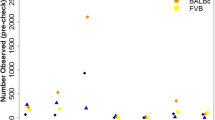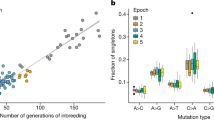Abstract
Characterizing the patterns of genetic variation in an organism provides fundamental insight into the evolutionary history of the organism and defines the scope and nature of studies that must be designed to correlate genotype to phenotype. Given the pre-eminent role of the inbred mouse in biomedical research, considerable effort has been undertaken in recent years to describe more fully the nature and amount of genetic variation among the numerous strains of mice that are in widest use. Here, we discuss recent studies that have contributed to an emerging understanding of the unique variation patterns found in inbred strains of mice and how they have arisen through a combination of natural evolution and human-directed breeding. These preliminary results have ramifications for genetic research into complex biomedical traits and are the basis for the development of future variation resources.
This is a preview of subscription content, access via your institution
Access options
Subscribe to this journal
Receive 12 print issues and online access
$209.00 per year
only $17.42 per issue
Buy this article
- Purchase on Springer Link
- Instant access to full article PDF
Prices may be subject to local taxes which are calculated during checkout


Similar content being viewed by others
References
Silver, L.M. Mouse Genetics (Oxford University Press, New York/Oxford, 1995).
Sachidanandam, R. et al. A map of human genome sequence variation containing 1.42 million single nucleotide polymorphisms. Nature 409, 928–933 (2001).
Gabriel, S.B. et al. The structure of haplotype blocks in the human genome. Science 296, 2225–2229 (2002).
Ferris, S.D., Sage, R.D., Prager, E.M., Ritte, U. & Wilson, A.C. Mitochondrial DNA evolution in mice. Genetics 105, 681–721 (1983).
Bonhomme, F., Guenet, J.-L., Dod, B., Moriwaki, K. & Bulfield, G. The polyphyletic origin of laboratory inbred mice and their rate of evolution. J. Linn. Soc. 30, 51–58 (1987).
Boursot, P., Auffray, J.-C., Britton-Davidian, J. & Bonhomme, F. The evolution of house mice. Annu. Rev. Ecol. Syst. 24, 119–152 (1993).
Sage, R.D., Heyneman, D., Lim, K.C. & Wilson, A.C. Wormy mice in a hybrid zone. Nature 324, 60–63 (1986).
Moulia, C. et al. Wormy mice in a hybrid zone: a genetic control of susceptibility to parasite infection. J. Evol. Biol. 4, 679–687 (1991).
Forejt, J., Vincek, V., Klein, J., Lehrach, H. & Loudova-Mickova, M. Genetic mapping of the t-complex region on mouse chromosome 17 including the Hybrid sterility-1 gene. Mamm. Genome 1, 84–91 (1991).
Prager, E.M., Orrego, C. & Sage, R.D. Genetic variation and phylogeography of central Asian and other house mice, including a major new mitochondrial lineage in Yemen. Genetics 150, 835–861 (1998).
Keeler, C.E. The Laboratory Mouse. Its Origin, Heredity, and Culture (Harvard University Press, Cambridge, 1931).
Morse, H.C. Introduction. in Origins of Inbred Mice (ed. Morse, H.C.) 1–31 (Academic, New York, 1978).
Yokenawa, H. et al. Relationship between laboratory mice and subspecies Mus musculus domesticus based on restriction endonuclease cleavage patterns of mitochondrial DNA. Jpn. J. Genet. 55, 289–296 (1980).
Ferris, S.D., Sage, R.D. & Wilson, A.C. Evidence from mtDNA sequences that common laboratory strains of inbred mice are descended from a single female. Nature 295, 163–165 (1982).
Bishop, C.E., Boursot, P., Baron, B., Bonhomme, F. & Hatat, D. Most classical Mus musculus domesticus laboratory mouse strains carry a Mus musculus musculus Y chromosome. Nature 315, 70–72 (1985).
Dietrich, W.F. et al. A comprehensive genetic map of the mouse genome. Nature 380, 149–152 (1996).
Lander, E.S. & Botstein, D. Mapping mendelian factors underlying quantitative traits using RFLP linkage maps. Genetics 121, 185–199 (1989).
Flint, J., Valdar, W., Shifman, S. & Mott, R. Strategies for mapping and cloning quantitative trait genes in rodents. Nat. Rev. Genet. 6, 271–286 (2005).
Mural, R.J. et al. A comparison of whole-genome shotgun-derived mouse chromosome 16 and the human genome. Science 296, 1661–1671 (2002).
Waterston, R.H. et al. Initial sequencing and comparative analysis of the mouse genome. Nature 420, 520–562 (2002).
Wade, C.M. et al. The mosaic structure of variation in the laboratory mouse genome. Nature 420, 574–578 (2002).
Zhang, J. et al. A high-resolution multistrain haplotype analysis of laboratory mouse genome reveals three distinctive genetic variation patterns. Genome Res. 15, 241–249 (2005).
Adams, D.J. et al. Complex haplotypes, copy number polymorphisms and coding variation in two recently divergent mouse strains. Nat. Genet. 37, 532–536 (2005).
Yalcin, B. et al. Unexpected complexity in the haplotypes of commonly used inbred strains of laboratory mice. Proc. Natl. Acad. Sci. USA 101, 9734–9739 (2004).
Frazer, K.A. et al. Segmental phylogenetic relationships of inbred mouse strains revealed by fine-scale analysis of sequence variation across 4.6 Mb of mouse genome. Genome Res. 14, 1493–1500 (2004).
Grupe, A. et al. In silico mapping of complex disease-related traits in mice. Science 292, 1915–1918 (2001).
Darvasi, A. In silico mapping of mouse quantitative trait loci. Science 294, 2423 (2001).
Pletcher, M.T. et al. Use of a dense single nucleotide polymorphism map for in silico mapping in the mouse. PLoS Biol. 2, e393 (2004).
Cervino, A.C. et al. Integrating QTL and high-density SNP analyses in mice to identify Insig2 as a susceptibility gene for plasma cholesterol levels. Genomics, published online 29 August 2005 (10.1016/j.ygeno.2005.07.010).
Ideraabdullah, F.Y. et al. Genetic and haplotype diversity among wild-derived mouse inbred strains. Genome Res. 14, 1880–1887 (2004).
Cooper, D.N. & Krawczak, M. Human Gene Mutation (BIOS Scientific, Oxford, 1993).
Cheung, J. et al. Recent segmental and gene duplications in the mouse genome. Genome Biol. 4, R47 (2003).
Snijders, A.M. et al. Mapping segmental and sequence variations among laboratory mice using BAC array CGH. Genome Res. 15, 302–311 (2005).
Chung, Y.J. et al. A whole-genome mouse BAC microarray with 1-Mb resolution for analysis of DNA copy number changes by array comparative genomic hybridization. Genome Res. 14, 188–196 (2004).
Li, J. et al. Genomic segmental polymorphisms in inbred mouse strains. Nat. Genet. 36, 952–954 (2004).
Singer, J.B. et al. Genetic dissection of complex traits with chromosome substitution strains of mice. Science 304, 445–448 (2004).
Acknowledgements
We thank B. Payseur for comments on an earlier draft of this work.
Author information
Authors and Affiliations
Corresponding author
Ethics declarations
Competing interests
The authors declare no competing financial interests.
Rights and permissions
About this article
Cite this article
Wade, C., Daly, M. Genetic variation in laboratory mice. Nat Genet 37, 1175–1180 (2005). https://doi.org/10.1038/ng1666
Published:
Issue Date:
DOI: https://doi.org/10.1038/ng1666
This article is cited by
-
Slc1a3-2A-CreERT2 mice reveal unique features of Bergmann glia and augment a growing collection of Cre drivers and effectors in the 129S4 genetic background
Scientific Reports (2021)
-
Genetic background modifies phenotypic and transcriptional responses in a C. elegans model of α-synuclein toxicity
BMC Genomics (2019)
-
Nested retrotransposition in the East Asian mouse genome causes the classical nonagouti mutation
Communications Biology (2019)
-
Propelling the paradigm shift from reductionism to systems nutrition
Genes & Nutrition (2017)
-
Genetic polymorphisms and their association with brain and behavioural measures in heterogeneous stock mice
Scientific Reports (2017)



